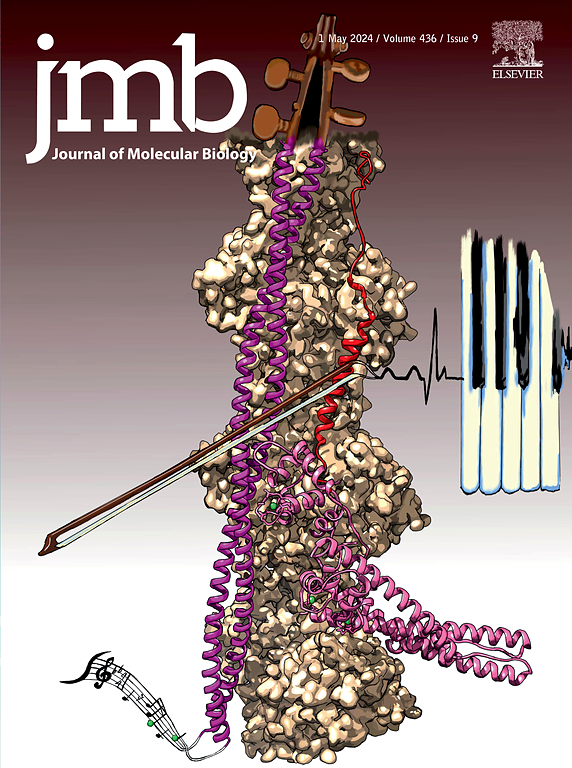构象异质性和近膜区域在Ephrin A1与EphA2受体配体结合域相互作用中的结构作用。
IF 4.5
2区 生物学
Q1 BIOCHEMISTRY & MOLECULAR BIOLOGY
引用次数: 0
摘要
Ephrin生长因子通过gpi锚定结构域或跨膜结构域附着在细胞膜上,已知具有双向信号:表达Ephrin的细胞在其受体Eph识别Ephrin时经历下游信号传导。这种双向性使ephrin成为一个有趣的药物靶点。在本工作中,我们通过核磁共振光谱研究了ephrin A1的构象异质性和近膜结构域在其与EphA2受体配体结合结构域相互作用中的作用。我们发现配体识别是通过构象选择机制发生的,膜旁区域是灵活的,非结构化的,不参与结合。本文章由计算机程序翻译,如有差异,请以英文原文为准。

Structural Role of Conformational Heterogeneity and Juxtamembrane Regions in the Ephrin A1 Interactions With the EphA2 Receptor Ligand-binding Domain
Ephrin growth factors are attached to the membrane by either GPI-anchor or transmembrane domains and are known to signal bi-directionally: cells, expressing the ephrins experience the downstream signaling in response to ephrin recognition by their receptor, Eph. This bidirectionality makes ephrins an interesting drug target. In the present work, we investigate the role played by conformational heterogeneity and juxtamembrane domains of Ephrin A1 in its interactions with the ligand-binding domain of EphA2 receptor by NMR spectroscopy. We show that ligand recognition occurs via a conformational selection mechanism and that the juxtamembrane regions are flexible, unstructured and are not involved in the binding.
求助全文
通过发布文献求助,成功后即可免费获取论文全文。
去求助
来源期刊

Journal of Molecular Biology
生物-生化与分子生物学
CiteScore
11.30
自引率
1.80%
发文量
412
审稿时长
28 days
期刊介绍:
Journal of Molecular Biology (JMB) provides high quality, comprehensive and broad coverage in all areas of molecular biology. The journal publishes original scientific research papers that provide mechanistic and functional insights and report a significant advance to the field. The journal encourages the submission of multidisciplinary studies that use complementary experimental and computational approaches to address challenging biological questions.
Research areas include but are not limited to: Biomolecular interactions, signaling networks, systems biology; Cell cycle, cell growth, cell differentiation; Cell death, autophagy; Cell signaling and regulation; Chemical biology; Computational biology, in combination with experimental studies; DNA replication, repair, and recombination; Development, regenerative biology, mechanistic and functional studies of stem cells; Epigenetics, chromatin structure and function; Gene expression; Membrane processes, cell surface proteins and cell-cell interactions; Methodological advances, both experimental and theoretical, including databases; Microbiology, virology, and interactions with the host or environment; Microbiota mechanistic and functional studies; Nuclear organization; Post-translational modifications, proteomics; Processing and function of biologically important macromolecules and complexes; Molecular basis of disease; RNA processing, structure and functions of non-coding RNAs, transcription; Sorting, spatiotemporal organization, trafficking; Structural biology; Synthetic biology; Translation, protein folding, chaperones, protein degradation and quality control.
 求助内容:
求助内容: 应助结果提醒方式:
应助结果提醒方式:


